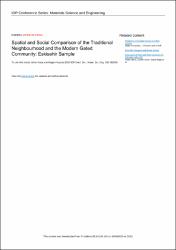| dc.contributor.author | Koca, Güler | |
| dc.contributor.author | Kayılıoğlu, Begüm | |
| dc.date.accessioned | 2019-10-21T19:43:49Z | |
| dc.date.available | 2019-10-21T19:43:49Z | |
| dc.date.issued | 2017 | |
| dc.identifier.issn | 1757-8981 | |
| dc.identifier.uri | https://dx.doi.org/10.1088/1757-899X/245/5/052009 | |
| dc.identifier.uri | https://hdl.handle.net/11421/19730 | |
| dc.description | World Multidisciplinary Civil Engineering-Architecture-Urban Planning Symposium (WMCAUS) -- JUN 12-16, 2017 -- Prague, CZECH REPUBLIC | en_US |
| dc.description | WOS: 000419056402091 | en_US |
| dc.description.abstract | People's expectations from the city have changed with the transformation of urban life. Urban space is not the only place where structures are formed. Urban space also consists of a combination of public spaces, semi-public spaces, and private spaces. As social and cultural phenomena, social events occur and people communicate with each other in these spaces. Therefore, streets and neighbourhoods composed of houses are not only physical spaces, but they also have important social and cultural dimensions. Modern life has brought a plethora of changes that affected the cities. Due to rapid changes today, the urban space forms in the conversion process are also designed differently. Historically, the space organization based on the streets of the semi-public life in Turkish cities has been transformed into mass housing and housing estate-style life in recent years. This transformation has been expressed differently in urban life not only physically, but also socially and culturally. The street which is regarded as a public space was a place where people communicated and social events happened in the past; but today, the streets are rife with security problems and they have become a concept evoking an image of street that is bordered with buildings. Spatial separation has emerged with middle and upper classes isolating themselves from the streets and heading towards gated communities, especially for security reasons. This social and spatial separation has begun to lead to various problems in cities. Eskisehir is an important Anatolian city located between Ankara, the capital of Turkey, and Istanbul. This research was conducted in two research sites in Eskisehir: one is a gated community where middle and upper-income groups reside, and the other is a residential neighbourhood where middle-income groups live. These groups were studied through a survey. The spatial preferences of the residents in these two areas and their relation with the neighbourhood are examined. These groups were surveyed and their relations with their relatives have been researched. | en_US |
| dc.language.iso | eng | en_US |
| dc.publisher | IOP Publishing LTD | en_US |
| dc.relation.ispartofseries | IOP Conference Series-Materials Science and Engineering | |
| dc.relation.isversionof | 10.1088/1757-899X/245/5/052009 | en_US |
| dc.rights | info:eu-repo/semantics/openAccess | en_US |
| dc.title | Spatial and Social Comparison of the Traditional Neighbourhood and the Modern Gated Community: Eskisehir Sample | en_US |
| dc.type | conferenceObject | en_US |
| dc.relation.journal | World Multidisciplinary Civil Engineering-Architecture-Urban Planning Symposium - Wmcaus | en_US |
| dc.contributor.department | Anadolu Üniversitesi, Mimarlık ve Tasarım Fakültesi, Mimarlık Bölümü | en_US |
| dc.identifier.volume | 245 | en_US |
| dc.relation.publicationcategory | Konferans Öğesi - Uluslararası - Kurum Öğretim Elemanı | en_US] |


















